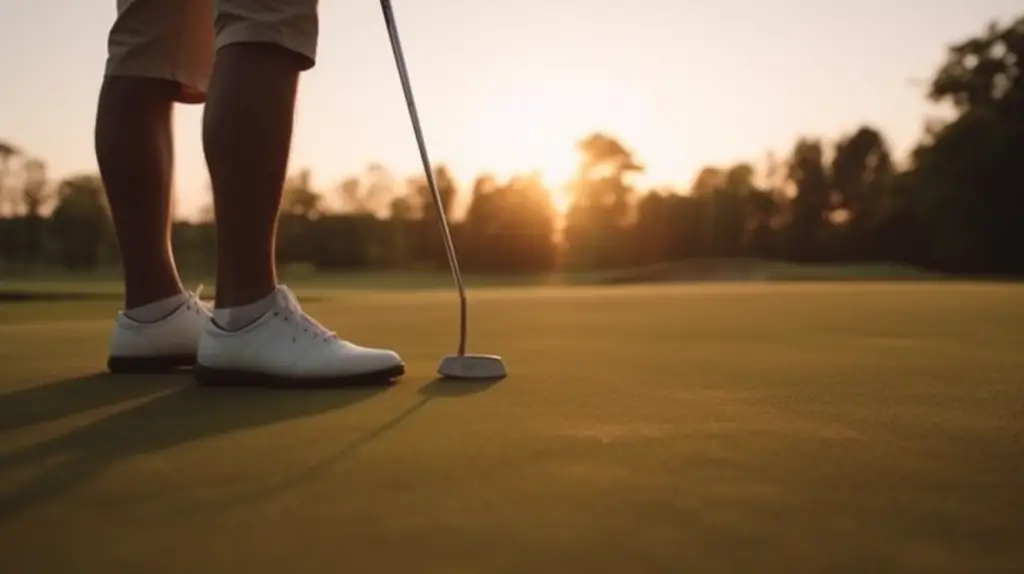Last Updated on November 22, 2023
Do you want to improve your golf game? Learning how to swing in-to-out is a great way for any golfer to increase their accuracy and add more power and control to their shots. This article will provide a step-by-step guide on how to correctly master this skill, so that you can easily hit the ball where you intend it to go.
Golfing isn’t just about hitting the ball hard…it’s also about being able to accurately place the ball wherever you need it. If you are having trouble getting your shots down the fairway or onto the green, learning how to swing in-to-out could be the solution! It might seem like an intimidating task, but with some practice and patience, anyone can learn this important technique.
By following these simple steps provided in this article, you’ll be well on your way to mastering the perfect golf shot! So read on and get ready to start improving your game today!
Definition Of Swing In To Out
Swinging in to out is a golf technique used by many players, from beginners to professionals. It involves rotating the clubhead on an outside-in path along the target line throughout the entire backswing and downswing. This type of swing helps create more power and accuracy in shots, leading to improved scores for those who use it correctly.
The concept behind swinging in to out is that when the clubface passes through impact with the ball, it will be slightly open relative to where it was at address – meaning that it has been swung so that its face points towards the right side (for right-handed golfers). This ensures greater control over shot direction and trajectory, as well as maximum distance off of each tee or fairway hit. Additionally, this type of swing allows for a better spin on all shots, allowing them to stop quickly once they reach their intended targets. All these factors make swinging in to out a powerful tool for any golfer looking for improved performance on the course.

Grip Considerations
When making grip changes, there are several things that need to be considered. The first is hand positions. Make sure your hands are in line with one another and that they remain steady throughout the entire swing. Keeping them in alignment will ensure that your clubface remains square to the target all the way through impact.
Additionally, it’s important to vary your grip pressure depending on whether you’re hitting a draw or fade shot; lighter grips work best for draws, while firmer grips help control fades and slices. Finally, adjusting your grip angle slightly can also provide more control over ball flight and trajectory.
Stance & Posture Requirements
When golfing, having the correct stance and posture is key. To swing from in to out properly, your stance should be wide enough so that you can comfortably make a full turn with your shoulders during the backswing. Your feet should also be parallel with each other, about shoulder-width apart. Additionally, it’s important for both of your arms to hang down freely – this will help maintain balance throughout the swing.
To ensure proper posture while making an in to out swing, start by positioning your body away from the target line. Then, hinge your wrists slightly upwards as you draw the club back until it reaches its highest point at the top of the backswing. From there, keep your elbows close together and rotate your hips and legs through impact towards the target line before releasing all of your power into the ball on the followthrough. This combination of shifting weight and rotating through impact will allow you to hit farther distances with more control and accuracy than just using arm strength alone.
Body Movement And Rotation Tips
The key to successful golf swings lies in body movement and rotation. To swing from in-to-out, your body must rotate correctly throughout the entire motion of the swing. During this process, you will need to ensure that your body is properly aligned with the ball and club head. This alignment should be maintained during all aspects of the swing mechanics for maximum impact on the ball.
When completing a full swing, it’s important to focus on body rotation rather than just arm movements. Your arms should move in tandem with your body as you make an in-to-out swing. If they don’t, then you’re likely not going to hit the ball far or accurately enough.
It’s also essential to practice proper hip turn so that your torso can stay connected to your arms through impact. The correct hip turn allows for powerful acceleration at impact, which generates more speed and distance for each shot. When done correctly, these techniques lead to improved accuracy and consistency in your shots – helping you drive those balls farther down the fairway!

Backswing Mechanics
Having reviewed the body movement and rotation tips, it is now time to discuss backswing mechanics. A solid golf swing requires a good understanding of the correct backswing technique in order to get maximum distance from each shot. Here are some key points for mastering your backswing:
- Maintain balance throughout the entire motion by keeping your head steady and feet firmly planted on the ground.
- Create an optimal swing plane by imagining a straight line between your hands that extends out towards the target.
- Keep tension off your arms and shoulders while swinging so you can maintain consistent control over the clubface.
The idea behind these principles is to maximize power transfer through proper sequencing of muscle contractions during the backswing. This will allow you to store potential energy within your muscles before releasing it at impact with full force and accuracy. Armed with this knowledge, you should be well-equipped to improve upon any existing flaws in your golf backswing and develop a more efficient swing plane.
Downswing Techniques
When swinging in to out, it’s important to understand the downswing mechanics and timing. During this phase of the swing, your body must be braced and prepared for a powerful uncoiling movement. From the top position, you should begin by shifting your weight onto your left side while keeping your arms connected close to your chest. As you start down, make sure that you keep the clubface aligned with an open face angle as you approach impact. Your arms will move faster than your lower body, so don’t forget to initiate this motion with a good shoulder turn. Doing all these things correctly is key for power and accuracy when hitting from an in-to-out swing path.
In order to achieve a successful shot shape, it’s essential that you maintain control throughout the entire downswing sequence leading into impact. This means maintaining proper clubhead speed and rotation through the contact point, without any early release or releasing too late during impact. It also involves having a balanced finish with an extension on both sides of the target line after ball strike; if done right, it can result in more consistent shots every time!
Common Mistakes To Avoid
Having an understanding of the correct downswing technique is important, but it’s only half the battle. To improve at golf and minimize backward progress, you must also be aware of common mistakes that could sabotage your swing. An incorrect clubhead path can cause shots to veer off target in either direction. An early release on impact causes a lack of power and accuracy. Having the wrong alignment will make finding your target difficult. Poor balance makes it hard to maintain control throughout the entire swing. Lastly, having an incorrect tempo may lead to inefficient use of momentum and inconsistent contact with the ball.
Be mindful and pay attention to these potential pitfalls during each practice session so that they don’t become habits when hitting real shots out on the course. Taking time for self-observation is essential if you want to develop a consistent swing motion that produces results.

Practising Drills For Improvement
One of the most effective golf practice drills to develop an in-to-out swing path is known as the ‘swing drill’. This drill begins with taking a normal grip on your club and then placing a second ball just outside the target line. The goal of this drill is to promote an in-to-out motion, making contact with both balls during each swing. It’s important to focus on body rotation through the shot so that you can keep up good momentum throughout your swing.
Additionally, it helps to maintain light grip pressure while swinging—too much pressure will result in too much tension and inhibit proper movement. With enough practice, you’ll be able to consistently hit shots with an in-to-out pattern from any lie or situation. As you work to improve your skillset and gain more confidence on the course, don’t forget about the importance of drilling for improvement. Put in some time at the range and make sure you’re getting comfortable with your current technique before tackling new challenges.
Equipment Adjustments
When it comes to swinging from in-to-out in golf, the equipment adjustments you make can be just as important as your swing technique. To help ensure a successful transition from an inside out swing pattern, here are some key pieces of club fitting advice that all golfers should consider:
| Golf Club Adjustment | Shaft Selection Tips | Lie Angle Considerations | Weight Balance Considerations |
|---|---|---|---|
| Loft and Lie | Length | Sole Width | Swingweight/MOI |
| Flex | Kickpoint | Bounce | shaft weight |
| Face Angle | Torque | Lie Angle | headweight |
Loft and lie adjustment is especially important for any golfer who wants to achieve a consistent ball flight with each shot. When selecting your shafts, remember to pick ones with the proper kick point and torque rating for your swing speed. Additionally, sole width and bounce must also be considered when adjusting the lie angle of your clubs. Finally, considering factors such as swingweight or moment of inertia (MOI), shaft weight, and headweights will ensure that every club in your bag is perfectly balanced for optimal performance.
Equipment adjustments are essential components of any golfer’s success on the course. The right combination of loft & lie angles, shaft selection tips, lie angle considerations, and weight balance considerations will allow players to effectively control their shots – ultimately ensuring they reach their desired destination on the green!
Frequently Asked Questions
Are There Any Mental Techniques To Help With My Swing In To Out?
When it comes to golf, certain techniques can help you improve your swing in to out. Mental techniques are just as important as physical ones; understanding the right mental tips and tricks can make a huge difference when swinging correctly.
There are plenty of mental techniques that can help with this type of swing technique. For example, visualizing yourself perfectly executing the desired movement is an effective way to practice even if you’re not on the course or range. Additionally, maintaining a positive attitude while playing will also help keep your mind sharp and focused on what needs to be done. Furthermore, taking deep breaths during each shot helps relax the body and allows for more accurate shots. With these mental tips, combined with proper swing techniques, any golfer should be able to properly execute their swings in no time!
How Do I Know If I’m Doing The Swing In To Out Correctly?
The first step towards assessing the accuracy of your swing should involve an analysis of its mechanics. It’s important to understand the basics of a good golf swing and identify any potential flaws in yours, such as incorrect clubhead angle and poor posture. Once you have identified any discrepancies between what you’re doing and what’s recommended by experienced players, you can start making adjustments to get closer to achieving the right swing direction – from inside out.
To make sure that all changes made are efficient and effective, it’s strongly recommended that you use video technology when practising swings at home or on the range. By recording yourself during practice sessions, it allows for more precise feedback than simply relying on auditory cues alone. You’ll also be able to review each take afterwards and determine which parts need further improvement before taking them back onto the course.
Conclusion
To summarize, swinging in to out is an important skill for any golfer. It requires the right club, consistency and practice drills to become proficient at it. Additionally, having a mental approach that helps you focus on your swing can make all the difference. After some time working on these skills, you’ll be able to recognize when you’re doing the swing correctly and apply it on the course with confidence.
As you continue to work on this skill, remember to stay patient and focused. The more often you practice this technique, the better results you will see. Don’t get frustrated if progress isn’t immediate – dedication and repetition are key here! A positive attitude also goes a long way in improving your golf game overall.
By becoming familiar with proper technique and developing effective practice routines for swinging in to out, you can eventually master this essential golf move and take your game up a notch. Good luck!



